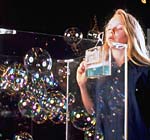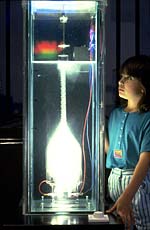
Bubble Tank
|
Bobbling Bubble Tank
Bubbles float on a sea of denser-than-air gas.
Elementary Changes
Find out about the properties of mercury and the effects of heating on iodine and mercury (II) iodide.
Flame Colours
A Bunsen burner flame burns with distinctive colours when different substances are heated in it. Salts of sodium, lithium, barium,
strontium, calcium and caesium, in aqueous
solution, are used in this experiment.
Frozen Shadows
Light makes phosphorescent wallpaper glow - here a flash freezes movement as a shadow!
Human Battery?
Compare the electric currents produced when touching different combinations of metal plates.
Inky Colours - paper chromatography,
Find out what is in a mixture of coloured substances using paper chromatography.
Invisible Light
See things glow under ultra-violet.
Molecular Lego
Make a molecule with model atoms then use a computer to find out what chemical you have made. Visitors assemble a molecule using
single-bond links between two carbon, one oxygen and six hydrogen `atoms' (actually large wooden balls).
Periodic Table - elements
A large periodic table with examples of many of the real elements.
Periodic Table Computer
A computer giving information about the elements and the periodic table.
Radioactivity
Uses a Geiger counter to measure the radioactivity of common materials.
Rainbows to the Stars
Different gases glow brightly in discharge tubes. Their spectrum colours are in lines giving a unique `fingerprint' which identifies each
gas. Astronomers can use this effect to identify the elements present in stars.
Smelly Chemicals - Carvones
A small change in the shape of a molecule can affect its smell dramatically.
Smelly Chemicals - Sense of smell
Clever chemical mimicry simulates natural odours.
 TASTRAK TASTRAK
A special plastic material can be developed to show latent alpha particle tracks. This exhibit allowed visitors to view tracks and take
part in a survey of natural radioactivity in their homes arising from radon gas.
Water with a Bang
(right) Electricity is used to split water into hydrogen and oxygen.

|